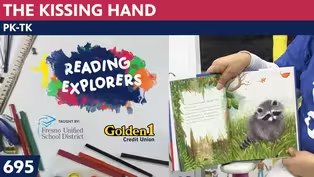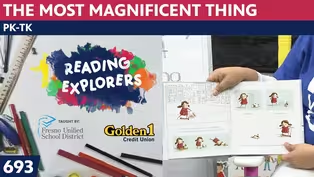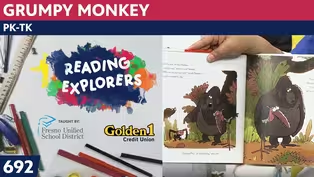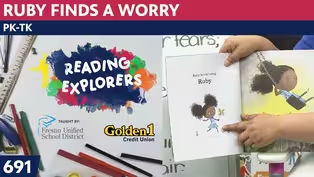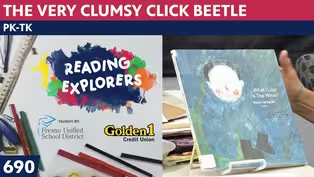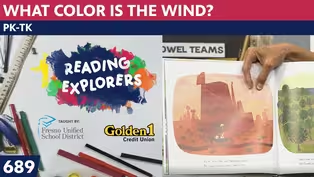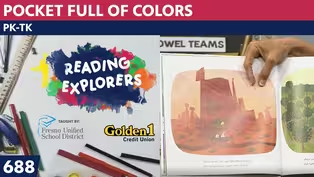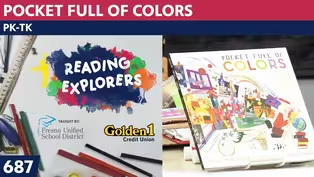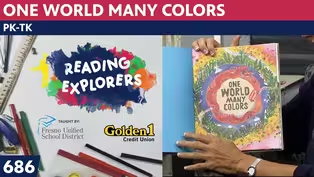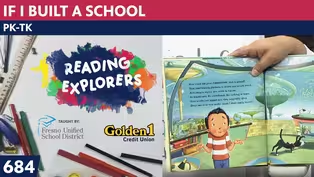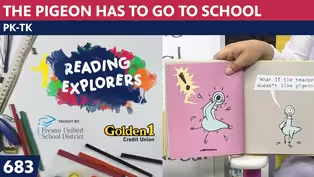
TK-345: Katsushika Hokusai
Season 3 Episode 246 | 14m 12sVideo has Closed Captions
Join Mrs. Readwright at Camp Discovery!
Transitional Kindergarten teacher, Mrs. Readwright, welcomes students back to Camp Discovery, a fun learning space packed with reading adventures & fun games!
Problems playing video? | Closed Captioning Feedback
Problems playing video? | Closed Captioning Feedback
Reading Explorers is a local public television program presented by Valley PBS

TK-345: Katsushika Hokusai
Season 3 Episode 246 | 14m 12sVideo has Closed Captions
Transitional Kindergarten teacher, Mrs. Readwright, welcomes students back to Camp Discovery, a fun learning space packed with reading adventures & fun games!
Problems playing video? | Closed Captioning Feedback
How to Watch Reading Explorers
Reading Explorers is available to stream on pbs.org and the free PBS App, available on iPhone, Apple TV, Android TV, Android smartphones, Amazon Fire TV, Amazon Fire Tablet, Roku, Samsung Smart TV, and Vizio.
Providing Support for PBS.org
Learn Moreabout PBS online sponsorshipMore from This Collection
Valley PBS and Fresno Unified School District have partnered with Golden 1 Credit Union to create Reading Explorers Lessons for grades Pre-Kindergarten through Third grade. The daily lessons will be taught by Fresno Unified School District teachers and are created to help students practice their reading skills and reinforce lessons during distance learning.
Video has Closed Captions
Valley PBS presents Reading Explorers Lessons for Pre-Kindergarten and TK. (26m 27s)
PK-TK-693-The Most Magnificent Thing
Video has Closed Captions
Valley PBS presents Reading Explorers Lessons for Pre-Kindergarten and TK. (26m 26s)
Video has Closed Captions
Valley PBS presents Reading Explorers Lessons for Pre-Kindergarten and TK. (26m 28s)
Video has Closed Captions
Valley PBS presents Reading Explorers Lessons for Pre-Kindergarten and TK. (26m 28s)
PK-TK-690: The Very Clumsy Click Beetle
Video has Closed Captions
Valley PBS presents Reading Explorers Lessons for Pre-Kindergarten and TK. (26m 22s)
PK-TK-689: What Color is the Wind?
Video has Closed Captions
Valley PBS presents Reading Explorers Lessons for Pre-Kindergarten and TK. (26m 21s)
PK-TK-688: Pocket Full of Colors
Video has Closed Captions
Valley PBS presents Reading Explorers Lessons for Pre-Kindergarten and TK. (25m 58s)
PK-TK-687: Dancing Through Fields of Colors
Video has Closed Captions
Valley PBS presents Reading Explorers Lessons for Pre-Kindergarten and TK. (26m 20s)
PK-TK-686: One World Many Colors
Video has Closed Captions
Valley PBS presents Reading Explorers Lessons for Pre-Kindergarten and TK. (27m 13s)
PK-TK-685: School is Wherever I am
Video has Closed Captions
Valley PBS presents Reading Explorers Lessons for Pre-Kindergarten and TK. (26m 32s)
PK-TK-684: If I Built a School
Video has Closed Captions
Valley PBS presents Reading Explorers Lessons for Pre-Kindergarten and TK. (26m 21s)
PK-TK-683: The Pigeon Has to Go to School
Video has Closed Captions
Valley PBS presents Reading Explorers Lessons for Pre-Kindergarten and TK. (26m 22s)
Providing Support for PBS.org
Learn Moreabout PBS online sponsorship(acoustic guitar music) ♪ Good morning to a brand new day ♪ ♪ Time to learn and the games to play ♪ ♪ Learning things is so much fun ♪ ♪ Learning is good for everyone ♪ (playful music) - Hello, early learners.
Welcome back to the art room.
It's me, Mrs. Readwright.
Let's start our day off with our hello song.
♪ Hello, nice to see you, everyone ♪ ♪ Hello, nice to see you, everyone ♪ ♪ Hello to you, hello to you ♪ ♪ Hello to you, hello to me ♪ ♪ Hello, nice to see you, everyone ♪ And this week we're ending up, but we're ending up on letter O.
We've done A, all the way ending with O.
And we're going to be talking today about a Japanese artist.
He was born in a place that is now Tokyo, Japan, but it was long ago and it was a time when they were walling Japan off from others.
Others could not come into Japan.
And he learned to be an artist from his father, who was a mirror maker and he was also a painter.
So he learned to paint very early in life and his father sent him off to art school when he was just a teenager.
And he started doing all kinds of painting, but what he is really known for is for his wood block cuttings.
So if you get a piece of wood, now they sell the wood with some kind of rubber on the top and you can carve it out and wherever the carves are, the paint won't go and you roll paint over it and then you print it.
That's what his printings were mostly done that way and he did a series of them.
The mountain in Japan called Mount Fuji is very important to the people of Japan and it is in all 36 of his woodblock prints that he did of the mountain, but he did one that was especially popular and it is his most well-known piece of art.
It's called The Great Wave.
But let's sing our song of the alphabet before we go on to the art, ready?
♪ A, B, C, D, E of art ♪ ♪ That's the way that we will start ♪ ♪ K is for kitchen, lobster starts with L ♪ ♪ M is for mother, we can tell ♪ ♪ N is for night, ocean starts with O ♪ ♪ Art and the alphabet, here we go.
♪ So here it is.
I wish that you were up close to it because it is such a powerful painting, a woodblock print, I should say.
It is so powerful because the way he did this, it looks like the waves are a claw.
And here is Mount Fuji.
Now, Mount Fuji is enormous, it's a big mountain, but he painted this wave to be such a great wave that it dwarfed or made this small.
And here it is coming up to crash down and crash over things, and a lot of times, people don't even notice there are ships in the ocean.
Did you see them when we first looked?
Look, and men are row, row, rowing.
They see that great wave about to crash on them and they try and row to keep their boat afloat because if that wave fills up their boat, it will make it sink.
And this one has already been swallowed up by a wave and you can see people wishing they weren't in that giant wave.
It'll take them up and crash them back to the ocean.
And back here, there are several other boats full of people rowing and they're rowing toward that mountain.
The mountain has snow on it, Mount Fuji does, and this snowy white looks like the claws, I told you, and coming down.
Now, if you would like to just paint it this way, that would be great.
The background is kind of peachy and I brought a peach piece of paper or tan piece of paper to put in the background.
I think, the way I wanted to do this but it hurt my hand when I tried it out, so it may be something you are not going to want to do, but I'm going to show you what I was thinking of and then maybe I might just have to go back to just painting and then putting the white paint on top.
Let me set this aside.
The Great Wave.
And we, even in kindergarten, this is a kindergarten print, kindergarten has a book called The Great Wave, and it is so interesting to hear the story of it and Katsushika Hokusai.
I always just say his last name, Hokusai, because his first name, I have to practice it over and over again.
Katsushika, Katsushika Hokusai.
And he painted this of himself.
There were no photographs of him, I looked for a long time and there were none.
But there are some sculptures of him, but they don't allow you to use that picture, you have to pay a lot of money to use the picture.
So let me put my table on top.
Why do I have this box lid, you wonder?
What is she doing with that box lid?
Putting my newspaper here.
I'll keep the box lid out.
I wasn't sure, do I want to use that peachy background or will I paint it later?
I'm was going to just see how it looks with my big wave.
Now, what I wanted to do was first paint some background of the ocean waves, and I was going to cut out, this box lid ripped, so I'm just going to cut it up, but I thought it would be great if I could cut pieces of cardboard into a wave and so it would stand out against the paper that I painted the ocean on.
So let me see how far I want to try this out.
And if you think cutting cardboard sounds fun to you, then you can ask a grownup to help you, because honestly, it hurt my hand and it gave me a little blister right here on my hand, so you have to be careful with cardboard if you've ever been a cardboard artist.
I like to cut cardboard and use it for all kinds of things, you know I save brown paper bags and I save any cardboard that comes in the mail with any of the packages I buy.
So let me just show you what I'm planning to do with this.
Oh, it's so hard to cut corrugated cardboard until you get into a little line where it makes the cardboard go up and down, up and down, up and down.
Let me cut this up here.
Oh, I should go here and just use that little hole as part of it that they cut for me.
Oh, oh, and I liked this lid because it was white and so when I go to make my waves, it will be there.
Okay, scrap away, put it here.
I think what I will do is start out using the blue we had leftover from yesterday to do part of the ocean so you can see where I am putting my cardboard.
So I'm just going to do a background of the water with a lot of water on it so you can see where my ocean is, and then I'll be adding darker colors and lighter colors, and then the white, finally.
Watercolors, if you use your watercolors, they will be fine for the background and then when you paint over with the white tempera paint, if you have that, or you can just use your white crayon like we did yesterday in a resist, so if I color over and get my ocean background in here.
And I also had thought about bringing a sponge.
You know how we sponge painted some things?
So I'm just making my ocean waves go across and it doesn't matter if it's kind of grainy and stretchy in between because I'm going to be adding my great wave.
Okay, stay.
I'll move this out of the way so it's not here.
Now I'm going to make my great wave, and what I'm going to do is start up here and make a curve for that claw-like ocean wave to come down.
I'm going to have to go from this way 'cause I can't turn my scissors when it gets in that far.
Oh, so hard to cut, boys and girls.
So don't feel like you have to do this part, but I thought wouldn't it be fun?
Especially if you have an older brother or sister who wants to do some of the ocean.
So there we go.
I can put this on here to see if it fits and it does.
Let me toss these over here, bring out my watercolor paints, and move those onto my place.
Remember, this is probably a project you'll need to do at your table.
So you can just watch how I'm doing it today and then you can make it at your table later.
Or if your teacher does it with you, I know there are a lot of teachers who are doing asynchronous time and they're having you paint and do things later.
So I'm going to paint in here on the inside because I'm looking at the wave and some of it comes up and then there's some more of dark blue down here.
And then all of this out here is all white.
So I can just make this all in here and let me put it on here and see if it shows, yep.
So I'm going to make a little edge of it just blue so I can see it on my white paper.
Oh, I think I like it standing up there.
Okay, now to get my white paint from keeping it in my egg carton, putting it over here, still keeping this out 'cause I'm still going to need to do some more ocean.
I can put this on here and make my paint a little runnier and then I will get my brush that has no paint on it.
and I can put the white paint on the edges and make it stand up 'cause it's all foamy, and I can put that on there.
I'm going to add a little bit more blue paint.
I think I'll paint all of this wave and then come back in with my white paint after 'cause I think that it won't show up on here very well.
Move my ocean out of the way, get it up here.
What other color do I want?
Maybe this one's a little darker.
Oh, that's that bluey green one and this is that blue one, and mix it in 'cause the ocean isn't just one color.
Depending how the light hits it, it's all different kinds, so I'm going to add some more to this to make it more interesting and more ocean wavy.
Now, if you want to use that tan paper to cut out some boats later, that might be fun, but see how I'm going to make it ocean wavy by just making my brush go across?
And if it doesn't look as good as I think, I'll just get a little more water and get it on there.
And I can make my ocean wave and add a little more color to it, and then I'll go back in with my white and dab, dab, dab it.
There we go.
Okay, I'm liking that pretty much.
So I'll get into here and get my white brush, wipe off some of the water, and go all along the edge.
And I have to make the sky so that the ocean wave can be seen and here is that color that is kind of peachy.
It's in the bottom of my lid.
Boys and girls, it's been a great week with you.
If we don't get to finish this, you know we can finish it when we're away from one another and bring it back.
I'm making that sky kind of that tanny, peachy color.
So next week, we're going to continue with the alphabet and we'll do all different artists that you have seen maybe in the past, or maybe not, maybe they'll be new artists.
But it's been a great week with you.
I thank you for participating and having fun with art and we can do our singing our goodbye song to one another, and then we'll say goodbye and I'll just keep painting, and then I'll add my ocean and I'll bring this art back to you.
Let me see how this looks.
Get a little more water for my white paint.
♪ Goodbye, see you next time, everyone ♪ ♪ Goodbye, see you next time, everyone ♪ ♪ Goodbye to you, goodbye to you ♪ ♪ Goodbye to you, goodbye to me ♪ ♪ Goodbye, see you next time, everyone ♪ Look how the ocean looks on here with the tan background.
I still have to add some more white paint to the top.
Don't you worry, because I will do it.
Oh, I like how it stands up like that though.
I have to add a little more back here.
Boys and girls, goodbye.
I'll see you next week, have a terrific weekend.
(acoustic guitar music) ♪ Good morning to a brand new day ♪ ♪ Time to learn and games to play ♪ ♪ Learning things is so much fun ♪ ♪ Learning is good for everyone ♪
Support for PBS provided by:
Reading Explorers is a local public television program presented by Valley PBS
